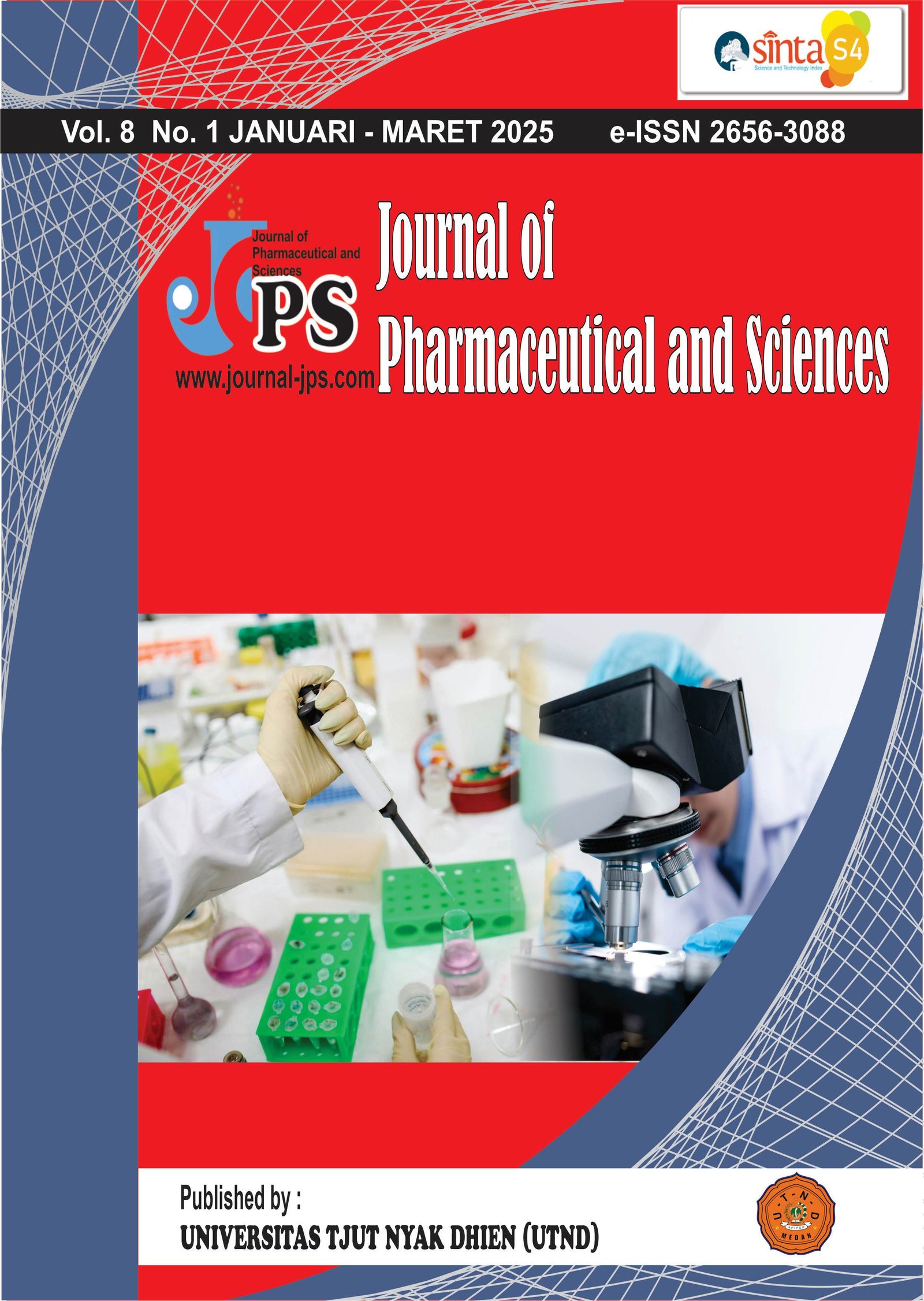Formulation of antibacterial hand cream based on chitosan and leaves of putri malu extract (Mimosa pudica L.)
Main Article Content
Page: 224-233
Abstract
CoronaVirus Disease 2019 is a respiratory disease caused by Severe Acute Respiratory Syndrome CoronaVirus 2 (SARS-CoV-2) which is transmitted through the air and droplets of fluid. One of the health protocols recommended by the World Health Organization (WHO) is washing hands. Hand-washing activities have limitations because not all places provide them, so the alternative that has been circulating in the community is hand sanitiser. However, the alcohol content and synthetic antibacterials cause dry and irritated skin. The purpose of this study was to create an antibacterial hand cream from putri malu leaf as a utilization of wild plants. Putri malu leaf extract and chitosan were made in the form of nanoparticles, and then an evaluation of the physical characteristics of the hand cream preparation was carried out in the form of pH, organoleptic, homogeneity, and stability observed for 14 days. The antibacterial activity of putri malu leaf extract and hand cream was tested against S. aureus and E. coli. The particle size obtained was 1529.5 ± 42.5 nm. The results of the physical characteristics obtained were pH 6.15; dark orange, odourless, stable at room temperature, and high homogeneity. Antibacterial testing of putri malu leaf extract against S. aureus produced an inhibition zone of 10.27 mm at a concentration of 25% and antibacterial hand cream produced inhibition zones of 23.18 mm and 12.22 mm with an extract concentration of 10% so both are classified as strong antibacterials that are effective against S. aureus and E. coli bacteria.
Downloads
Article Details

This work is licensed under a Creative Commons Attribution-NonCommercial-ShareAlike 4.0 International License.
References
Shu M. Formulasi sediaan gel hand sanitizer dengan bahan aktif triklosan 0,5% dan 1%. Jurnal Ilmiah Mahasiswa Universitas Surabaya 2013; 2(1):1–14.
Usman Y. Pemanfaatan potensi limbah kulit bawang merah (Allium cepa L.) sebagai sediaan gel hand sanitizer. Jurnal Riset Kefarmasian Indonesia 2020;2(2):63–71. DOI: https://doi.org/10.33759/jrki.v2i2.79
Anggita A, Fakhrurazzi, Harris A. Uji aktivitas antibakteri ekstrak etanol daun putri malu (Mimosa pudica) terhadap bakteri Pseudomonas aeruginosa. Jurnal Ilmiah Mahasiswa Veteriner 2018;2(3):411–418.
Khalish VA, Harminarti N, Katar Y. Uji potensi ekstrak daun putri malu (Mimosa pudica Linn) yang tumbuh di Padang sebagai larvasida nabati terhadap mortalitas larva nyamuk Aedes aegypti. Jurnal Kesehatan Andalas 2020;9(2):195–201. DOI: https://doi.org/10.25077/jka.v9i2.1250
Winarsih S, Khasanah U, Alfatah AH. Aktivitas antibiofilm fraksi etil asetat ekstrak daun putri malu (Mimosa pudica) pada bakteri methicilin-resistant Staphylococcus aureus (MRSA) secara in vitro. Majalah Kesehatan 2019;6(2):76–85. DOI: https://doi.org/10.21776/ub.majalahkesehatan.006.02.1
Farida Y, Rahmat D, Amanda AW. Uji Aktivitas Antiinflamasi Nanopartikel Ekstrak Etanol Rimpang Temulawak (Curcuma xanthorrhiza Roxb.) dengan Metode Penghambatan Denaturasi Protein, Fakultas Farmasi Universitas Pancasila, Jakarta Selatan. Jurnal Ilmu Kefarmasian Indonesia 2018;16(2):225–230. DOI: https://doi.org/10.35814/jifi.v16i2.569
Putri AI, Sundaryono A, Candra IN. Karakterisasi nanopartikel kitosan ekstrak daun ubi jalar (Impoea batatas L.) menggunakan metode gelasi ionik. Jurnal Pendidikan dan Ilmu Kimia 2018;2(2):203–207. DOI: https://doi.org/10.33369/atp.v2i2.7561
Yang MH, Yuan SS, Huang YF, Lin PC, Lu CY, Chung TW, Tyan YC. A proteomic view to characterize the effect of chitosan nanoparticle to hepatic cells: is chitosan nanoparticle an enhancer of PI3K/AKT1/mTOR pathway?. BioMed Research International 2014;2014(1):789591. DOI: https://doi.org/10.1155/2014/789591
Paramitha DAI, Sibarani J, Suaniti NM. Sifat fisikokimia hand and body cream dengan pemanfaatan ekstrak etanol bunga gemitir (Tagetes erecta L.) dan bunga pacar air merah (Impatienrs balsamina L.) dari limbah canang. Cakra Kimia 2017;5(1):1–11. DOI: https://doi.org/10.24843/CK.2017.v05.i01.p01
Sumbayak AR, Diana VE. Formulasi hand body lotion ekstrak etanol kulit buah semangka (Citrillus vulgaris). Jurnal Dunia Farmasi 2018;2(2):70–76. DOI: https://doi.org/10.33085/jdf.v2i2.4398
Dominica D, Handayani D. Formulasi dan evaluasi sediaan lotion dari ekstrak daun lengkeng (Dimocarpus longan) sebagai antioksidan. Jurnal Farmasi dan Ilmu Kefarmasian Indonesia 2019;6(1):1–7. DOI: https://doi.org/10.20473/jfiki.v6i12019.1-7
Santoso J, Herowati R, Murrukhmihadi M. Optimasi formula krim ekstrak poliherbal sebagai antibakteri dengan kombinasi gliserin, sorbitol dan propilenglikol sebagai humektan. Jurnal Para Pemikir 2018;7(2):270–274. DOI: https://doi.org/10.30591/pjif.v7i2.927
Wendersteyt NV, Wewengkang DS, Abdullah SS. Antimicrobial activity test of extracts and fractions of ascidian Herdmania momus from bangka island waters likupang against the growth of Staphylococcus aureus, Salmonella typhimurium, and Candida albicans. Pharmacon 2021;10(1):706–712. DOI: https://doi.org/10.35799/pha.10.2021.32758
Suryani S, Wahyuni W, Ariastika D, Rahmanpiu R. Formulasi nanopartikel kurkumin dengan teknik gelasi ionik menggunakan kitosan, tripolifosfat dan natrium alginat serta uji stabilitasnya secara in vitro. Majalah Farmasi, Sains, dan Kesehatan 2016;2(1):17–21.
Mi FL, Shyu SS, Lee ST, Wong TB. Kinetic study of chitosan-tripolyphosphate complex reaction and acid-resistive properties of the chitosan-tripolyphosphate gel beads prepared by in-liquid curing method. J. Polym. Sci: Polym. Phys 1999;37:1551–1564. DOI: https://doi.org/10.1002/(SICI)1099-0488(19990715)37:14<1551::AID-POLB1>3.3.CO;2-8
Desiati RD, Sugiarti E, Ramandhany S. Analisa ukuran partikel serbuk komposit NiCrAl dengan penambahan reaktif elemen untuk aplikasi lapisan tahan panas. Metalurgi 2018;1: 27–38. DOI: https://doi.org/10.14203/metalurgi.v33i1.358
Laili HN, Winarti L, Sari LORK. Preparasi dan karakterisasi nanopartikel kitosan-naringenin dengan variasi rasio massa kitosan-natrium tripolifosfat. Jurnal Pustaka Kesehatan 2014;2(2): 308–313.
Rismana E, Kusumaningrum S, Bunga O. Pengujian aktivitas antiacne nanopartikel kitosan–ekstrak kulit buah manggis (Garcinia Mangostana). Media Penelitian dan Pengembangan Kesehatan 2014;24(1):19–27. DOI: https://doi.org/10.22435/mpk.v24i1.3483.19-27
Ibekwe CA, Oyatogun GM, Esan TA, Oluwasegun KM. Synthesis and characterization of chitosan/gun arabic nanoparticles for bone regeneration. American Journal of Materials Science and Engineering 2017;5(1):28–36. https://doi.org/10.12691/ajmse-5-1-4. DOI: https://doi.org/10.12691/ajmse-5-1-4
Tanjung YP, Akmal T, Virginia H. Formulation of hand cream essential oil of basil (Ocimum basilicum) leaves. Indonesian Journal of Pharmaceutical Science and Technology 2022;1(1):33–40. DOI: https://doi.org/10.24198/ijpst.v1i1.41529
Davis WW, Stout TR. Disc plate methods of microbiological antibiotic assay. Microbiology 1971;22(4):659–665. https://doi.org/10.1128/am.22.4.659-665. DOI: https://doi.org/10.1128/AEM.22.4.659-665.1971
Fadlian, Hamzah B, Abram PH. Uji efektivitas ekstrak tanaman putri malu (Mimoda pudica Linn) sebagai bahan pengawet alami tomat. Jurnal Akademika Kimia 2016; 5(4):153–158. DOI: https://doi.org/10.22487/j24775185.2016.v5.i4.8063
Nurhayati, L.S., Yahdiyani, N., & Hidayatulloh, A. (2020). Perbandingan pengujian aktivitas antibakteri starter yogurt dengan metode difusi sumuran dan metode difusi cakram. Jurnal Teknologi Hasil Peternakan, 1(2): 41–46. DOI: https://doi.org/10.24198/jthp.v1i2.27537
Suherman B, Latif M, Dewi STR. Potensi kitosan kulit udang vannemei (Litopenaeus vannamei) sebagai antibakteri terhadap Staphylococccus epidermidis, Pseudomonas aeruginosa, Propionibacterium agnes, dan Escherichia coli dengan metode difusi cakram kertas. Media Farmasi 2018;18(1):116–127. DOI: https://doi.org/10.32382/mf.v14i1.145





